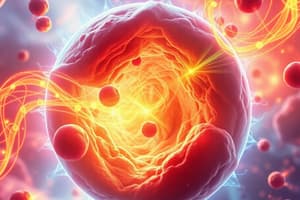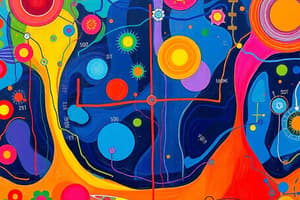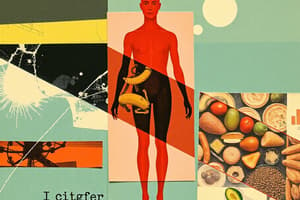Podcast
Questions and Answers
What is the normal fasting blood glucose range?
What is the normal fasting blood glucose range?
- 90-126 mg/dL (correct)
- 126-180 mg/dL
- 100-150 mg/dL
- 70-100 mg/dL
What is the main organ responsible for glucose homeostasis?
What is the main organ responsible for glucose homeostasis?
- Pancreas
- Liver (correct)
- Spleen
- Kidney
Which of the following is NOT a stage of fatty liver disease?
Which of the following is NOT a stage of fatty liver disease?
- Cirrhosis
- Hemochromatosis (correct)
- Steatosis
- Hepatocellular carcinoma
How does exercise affect glucose utilization?
How does exercise affect glucose utilization?
What is the approximate glucose output of the liver per minute?
What is the approximate glucose output of the liver per minute?
What role does ATP play in cellular metabolism?
What role does ATP play in cellular metabolism?
Which process involves the synthesis of complex molecules from simpler ones?
Which process involves the synthesis of complex molecules from simpler ones?
How does the structure of ATP facilitate its function?
How does the structure of ATP facilitate its function?
What is the effect of stress on metabolism?
What is the effect of stress on metabolism?
What must be restored for proper cellular function when nutrient intake is imbalanced?
What must be restored for proper cellular function when nutrient intake is imbalanced?
Which step in the central dogma of molecular biology is responsible for converting DNA into mRNA?
Which step in the central dogma of molecular biology is responsible for converting DNA into mRNA?
What effect does allosteric regulation have on enzyme activity?
What effect does allosteric regulation have on enzyme activity?
Which macronutrient provides the highest thermic effect during digestion?
Which macronutrient provides the highest thermic effect during digestion?
What is the term for the process that occurs when the body stores excess carbohydrates as glycogen?
What is the term for the process that occurs when the body stores excess carbohydrates as glycogen?
What does the first law of thermodynamics state?
What does the first law of thermodynamics state?
Which process accurately measures the energy expenditure during physical activity?
Which process accurately measures the energy expenditure during physical activity?
Which factor is NOT influencing resting energy expenditure (REE)?
Which factor is NOT influencing resting energy expenditure (REE)?
What is the typical contribution of basal metabolism to daily energy expenditure?
What is the typical contribution of basal metabolism to daily energy expenditure?
What interaction occurs during mRNA splicing?
What interaction occurs during mRNA splicing?
Which of the following is NOT a function of micronutrients in metabolism?
Which of the following is NOT a function of micronutrients in metabolism?
What does thermogenesis refer to?
What does thermogenesis refer to?
What percentage of total caloric intake is typically considered energy lost in feces, urine, and respiration?
What percentage of total caloric intake is typically considered energy lost in feces, urine, and respiration?
Which nutrient is associated with the highest caloric value per gram?
Which nutrient is associated with the highest caloric value per gram?
What is the primary role of coenzymes in metabolic processes?
What is the primary role of coenzymes in metabolic processes?
What is the primary product of the reaction catalyzed by citrate synthase?
What is the primary product of the reaction catalyzed by citrate synthase?
Which enzyme catalyzes the conversion of isocitrate to α-ketoglutarate?
Which enzyme catalyzes the conversion of isocitrate to α-ketoglutarate?
What does α-ketoglutarate dehydrogenase produce from α-ketoglutarate?
What does α-ketoglutarate dehydrogenase produce from α-ketoglutarate?
What is one of the end products of the TCA cycle per acetyl-CoA molecule?
What is one of the end products of the TCA cycle per acetyl-CoA molecule?
Which statement correctly describes the role of calcium in the TCA cycle?
Which statement correctly describes the role of calcium in the TCA cycle?
In electron transport, what is the role of coenzyme Q (ubiquinone)?
In electron transport, what is the role of coenzyme Q (ubiquinone)?
Which complex in the electron transport chain is primarily responsible for pumping protons out of the mitochondrial matrix?
Which complex in the electron transport chain is primarily responsible for pumping protons out of the mitochondrial matrix?
What occurs during beta oxidation of fatty acids?
What occurs during beta oxidation of fatty acids?
What is the final product when cytochrome C oxidase reduces oxygen?
What is the final product when cytochrome C oxidase reduces oxygen?
Which of the following is an inhibitor of the electron transport chain?
Which of the following is an inhibitor of the electron transport chain?
Which statement about complex II in the electron transport chain is true?
Which statement about complex II in the electron transport chain is true?
What type of reaction do flavoproteins primarily facilitate?
What type of reaction do flavoproteins primarily facilitate?
How are protons transported across the mitochondrial membrane during oxidative phosphorylation?
How are protons transported across the mitochondrial membrane during oxidative phosphorylation?
Which statement accurately describes the process of ATP generation during exercise?
Which statement accurately describes the process of ATP generation during exercise?
What happens to the energy status of a cell when the ATP:ADP ratio is high?
What happens to the energy status of a cell when the ATP:ADP ratio is high?
In glycolysis, what is the first step that consumes ATP?
In glycolysis, what is the first step that consumes ATP?
What structural feature of the inner mitochondrial membrane contributes to the energy gradient?
What structural feature of the inner mitochondrial membrane contributes to the energy gradient?
Which enzyme is responsible for converting 1,3-bisphosphoglycerate to 3-phosphoglycerate in glycolysis?
Which enzyme is responsible for converting 1,3-bisphosphoglycerate to 3-phosphoglycerate in glycolysis?
During glycolysis, how many ATP molecules are produced net after processing one molecule of glucose?
During glycolysis, how many ATP molecules are produced net after processing one molecule of glucose?
Which statement describes the role of NAD+ in metabolic reactions?
Which statement describes the role of NAD+ in metabolic reactions?
What occurs during the phase of glycolysis involving the oxidation of glyceraldehyde-3-phosphate?
What occurs during the phase of glycolysis involving the oxidation of glyceraldehyde-3-phosphate?
How does phosphocreatine contribute to ATP generation during exercise?
How does phosphocreatine contribute to ATP generation during exercise?
Which metabolic pathway is responsible for the complete oxidation of acetyl-CoA to carbon dioxide?
Which metabolic pathway is responsible for the complete oxidation of acetyl-CoA to carbon dioxide?
What is the primary product of glycolysis per glucose molecule?
What is the primary product of glycolysis per glucose molecule?
What is the role of the enzyme phosphofructokinase-1 in glycolysis?
What is the role of the enzyme phosphofructokinase-1 in glycolysis?
What happens to muscle energy storage when ATP levels are low?
What happens to muscle energy storage when ATP levels are low?
Which enzyme is responsible for removing glucose residues from glycogen?
Which enzyme is responsible for removing glucose residues from glycogen?
What is the primary function of liver glycogen?
What is the primary function of liver glycogen?
Which of the following statements about glucose-6-phosphate is false?
Which of the following statements about glucose-6-phosphate is false?
How does glycogenolysis begin?
How does glycogenolysis begin?
In which tissue does glucose-6-phosphate enter glycolysis for energy production?
In which tissue does glucose-6-phosphate enter glycolysis for energy production?
What is the role of pyridoxal phosphate in glycogen phosphorylase reactions?
What is the role of pyridoxal phosphate in glycogen phosphorylase reactions?
What triggers the breakdown of glycogen into glucose-1-phosphate?
What triggers the breakdown of glycogen into glucose-1-phosphate?
Which of the following tissues cannot convert glucose-6-phosphate into glucose?
Which of the following tissues cannot convert glucose-6-phosphate into glucose?
What is the result of hydrolysis of glucose-6-phosphate in the liver?
What is the result of hydrolysis of glucose-6-phosphate in the liver?
Which is NOT an outcome of glycolysis?
Which is NOT an outcome of glycolysis?
Which statement regarding glycogen is accurate?
Which statement regarding glycogen is accurate?
What is the function of the enzyme phosphoglucomutase?
What is the function of the enzyme phosphoglucomutase?
Which of the following enzymes is primarily involved in converting glucose-6-phosphate for energy utilization?
Which of the following enzymes is primarily involved in converting glucose-6-phosphate for energy utilization?
Flashcards
Metabolism
Metabolism
The set of chemical reactions in the body that sustain life, involving enzymatic reactions affected by food intake and energy expenditure.
ATP
ATP
Adenosine triphosphate, the primary energy carrier in living cells, consisting of a ribose sugar, adenine, and three phosphate groups.
Anabolism
Anabolism
The process of synthesizing complex molecules from simpler ones, requiring energy (ATP).
Catabolism
Catabolism
Signup and view all the flashcards
Metabolic Regulation
Metabolic Regulation
Signup and view all the flashcards
Blood Sugar Normal Range
Blood Sugar Normal Range
Signup and view all the flashcards
Hypoglycemia
Hypoglycemia
Signup and view all the flashcards
Glucose Homeostasis
Glucose Homeostasis
Signup and view all the flashcards
Glucogenesis
Glucogenesis
Signup and view all the flashcards
Stages of Fatty Liver Disease
Stages of Fatty Liver Disease
Signup and view all the flashcards
Phosphocreatine
Phosphocreatine
Signup and view all the flashcards
Substrate-level phosphorylation
Substrate-level phosphorylation
Signup and view all the flashcards
Oxidation
Oxidation
Signup and view all the flashcards
Reduction
Reduction
Signup and view all the flashcards
NADH
NADH
Signup and view all the flashcards
FADH2
FADH2
Signup and view all the flashcards
Mitochondrial membrane permeability
Mitochondrial membrane permeability
Signup and view all the flashcards
Cell energy status
Cell energy status
Signup and view all the flashcards
Glycolysis
Glycolysis
Signup and view all the flashcards
TCA Cycle
TCA Cycle
Signup and view all the flashcards
Enzyme's role in pathways
Enzyme's role in pathways
Signup and view all the flashcards
Pyruvate oxidation
Pyruvate oxidation
Signup and view all the flashcards
ATP Yield from Glycolysis
ATP Yield from Glycolysis
Signup and view all the flashcards
Lipogenesis
Lipogenesis
Signup and view all the flashcards
Amylose
Amylose
Signup and view all the flashcards
Glycogen
Glycogen
Signup and view all the flashcards
Glycogen Storage Locations
Glycogen Storage Locations
Signup and view all the flashcards
Glycogenolysis
Glycogenolysis
Signup and view all the flashcards
Glycogen Phosphorylase
Glycogen Phosphorylase
Signup and view all the flashcards
Debranching Enzyme
Debranching Enzyme
Signup and view all the flashcards
Phosphoglucomutase
Phosphoglucomutase
Signup and view all the flashcards
Glucose-6-Phosphate
Glucose-6-Phosphate
Signup and view all the flashcards
Liver G6P Dephosphorylation
Liver G6P Dephosphorylation
Signup and view all the flashcards
Glucose Contribution to Blood
Glucose Contribution to Blood
Signup and view all the flashcards
Rate Limiting Step of Glycolysis
Rate Limiting Step of Glycolysis
Signup and view all the flashcards
Pyruvate Fates
Pyruvate Fates
Signup and view all the flashcards
Triose phosphate isomerase deficiency
Triose phosphate isomerase deficiency
Signup and view all the flashcards
Glucose Transport Mechanism
Glucose Transport Mechanism
Signup and view all the flashcards
Glycogen Degradation Pathway
Glycogen Degradation Pathway
Signup and view all the flashcards
Central Dogma of DNA
Central Dogma of DNA
Signup and view all the flashcards
mRNA Processing
mRNA Processing
Signup and view all the flashcards
Allosteric Regulation
Allosteric Regulation
Signup and view all the flashcards
Energy Balance
Energy Balance
Signup and view all the flashcards
First Law of Thermodynamics
First Law of Thermodynamics
Signup and view all the flashcards
Macronutrients
Macronutrients
Signup and view all the flashcards
Micronutrients
Micronutrients
Signup and view all the flashcards
Thermal Effects of Food
Thermal Effects of Food
Signup and view all the flashcards
Glycogen Spillover
Glycogen Spillover
Signup and view all the flashcards
Resting Metabolic Rate (RMR)
Resting Metabolic Rate (RMR)
Signup and view all the flashcards
Thermogenesis
Thermogenesis
Signup and view all the flashcards
Indirect Calorimetry
Indirect Calorimetry
Signup and view all the flashcards
Adenosine Triphosphate (ATP)
Adenosine Triphosphate (ATP)
Signup and view all the flashcards
Energy Yield from Hydrolysis
Energy Yield from Hydrolysis
Signup and view all the flashcards
Citrate Formation
Citrate Formation
Signup and view all the flashcards
Aconitase
Aconitase
Signup and view all the flashcards
Isocitrate Dehydrogenase
Isocitrate Dehydrogenase
Signup and view all the flashcards
Alpha-Ketoglutarate Dehydrogenase
Alpha-Ketoglutarate Dehydrogenase
Signup and view all the flashcards
Succinyl-CoA Synthetase
Succinyl-CoA Synthetase
Signup and view all the flashcards
Succinate Dehydrogenase
Succinate Dehydrogenase
Signup and view all the flashcards
Fumarase
Fumarase
Signup and view all the flashcards
Malate Dehydrogenase
Malate Dehydrogenase
Signup and view all the flashcards
Macronutrient Oxidation
Macronutrient Oxidation
Signup and view all the flashcards
Chemiosmotic Theory
Chemiosmotic Theory
Signup and view all the flashcards
Electron Transport Chain
Electron Transport Chain
Signup and view all the flashcards
Ubiquinone (Coenzyme Q)
Ubiquinone (Coenzyme Q)
Signup and view all the flashcards
Complex I
Complex I
Signup and view all the flashcards
Complex IV
Complex IV
Signup and view all the flashcards
ETC Inhibitors
ETC Inhibitors
Signup and view all the flashcards
Study Notes
Macronutrients and Energy Balance
- Metabolism is a set of chemical reactions that sustain life, consisting of enzymatic reactions affected by food intake and energy expenditure. It varies between individuals.
- ATP is the primary energy carrier in cells, composed of 3 phosphate groups, a ribose sugar, and adenine. Its structure allows for multiple energy-releasing reactions and movement to different cell compartments.
- Metabolic regulation maintains homeostasis by controlling anabolic (building complex molecules) and catabolic (breaking down molecules) processes.
- Imbalance requires restoring ATP to cells for proper function.
- Nutrient intake (excess or inadequate) and environmental changes trigger metabolic responses.
- Regulation occurs through short-term (hours) and long-term (weeks) mechanisms, including responses at a cellular level (transcription, translation, post-transcriptional, and post-translational steps).
Central Dogma of DNA
- DNA is transcribed into mRNA.
- mRNA is translated into a protein, including amino acid chains.
- mRNA processing involves exons (coding regions) and introns (non-coding regions).
Allosteric Regulation of Enzymes
- Allosteric regulation of enzymes occurs when a molecule binds to a site separate from the active site, either inhibiting or activating the enzyme's activity.
Energy Balance
- Energy balance is maintained when energy intake matches energy expenditure (basal metabolism, thermal effect of food, and physical activity).
- Basal metabolism accounts for 70% of energy expenditure.
- Thermal effect of food accounts for 10%.
- Physical activity accounts for 20%.
Macronutrients and Caloric Intake
- Macronutrients are the bulk of calorie intake and include carbohydrates, proteins, and lipids.
- Micronutrients are important for facilitators in metabolism.
- About 90% of available energy is from ingested calories, with 10% loss through bodily functions (feces, urine, respiration).
- The thermic effect of food is determined by nutrients and their caloric content.
Methods of Measuring Energy Expenditure
- Indirect calorimetry measures gases produced, including resting energy expenditure (REE) and exercise energy expenditure (exercise).
- DEXA measures lean vs fat mass.
Adenosine Triphosphate (ATP)
- ATP consists of 3 phosphate groups linked together by high-energy bonds.
- ATP is used to drive chemical reactions in cells during muscle contraction.
Oxidation/Reduction Reactions
- Oxidation is the loss of electrons and reduction is the gain of electrons.
- Electron donors are oxidized, and acceptors are reduced.
- NAD+ is reduced to NADH and FAD to FADH2.
Mitochondria
- Mitochondria are structures inside cells that generate energy.
- Mitochondria have an outer and inner membrane, and a matrix with proteins for energy production.
- They use substrate level phosphorylation to create ATP from ADP.
Cell Energy Status
- A high ATP:ADP and NADH:NAD+ ratio indicates sufficient energy. A low ratio indicates a need for energy.
Glycolysis
- Glycolysis is a metabolic pathway in the cytoplasm breaking down glucose to generate ATP. Glucose transforms to pyruvate, a 10-step reaction involving different enzymes. Two ATP are used initially and four are produced in the latter stages of glycolysis for a net gain of 2 ATP.
TCA Cycle (Krebs Cycle)
- The TCA cycle oxidizes acetyl-CoA, generating NADH, FADH2 (high-energy carriers), and ATP.
- It consists of several steps, producing molecules and energy through reactions using various enzymes.
Beta Oxidation
- Beta oxidation is the primary pathway for fatty acid breakdown, generating acetyl-CoA, NADH, and FADH2 that enter the TCA Cycle.
Electron Transport Chain
- The electron transport chain uses electron carriers to drive the synthesis of ATP, and creates an electrochemical gradient within the mitochondrial membrane using proton pumps.
- Four protein complexes (I-IV) are involved. Ubiquinone and cytochrome c are mobile electron carriers.
Regulatory Reactions of the TCA Cycle
- Regulatory mechanisms for the TCA cycle control substrate availability and enzyme activity. Changes in this cycle impact the energy production of cells.
Macronutrient Metabolism (Carbohydrates)
- Simple carbohydrates include monosaccharides and disaccharides. Complex carbohydrates are oligosaccharides and polysaccharides.
- Glucose metabolism is important to maintain blood sugar and the liver is a key organ.
- Glycogens production and regulation plays a role in managing glucose levels. Glucose-6-phosphatase converts glucose-6-phosphate to glucose to release it into the bloodstream. This occurs in the liver.
- Glycogenolysis is the breakdown of glycogen; it creates glucose 1-phosphate and glucose 6-phosphate which enters the glycolysis pathway. Different enzymatic pathways control the process and it occurs differently in various tissues.
Fates of Pyruvate
- Pyruvate has several fates, including becoming acetyl-CoA and ultimately entering the TCA cycle or anaerobic conditions generating lactate in vertebrates/ ethanol in microorganisms.
Studying That Suits You
Use AI to generate personalized quizzes and flashcards to suit your learning preferences.




